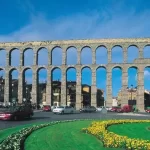Sewer, conduit that carries wastewater from its source to a point of treatment and disposal. The wastewater may be domestic (sanitary) sewage, industrial sewage, storm runoff, or a mixture of the three. Large-diameter pipes or tunnels that carry a mixture of the three types of liquid wastes, called combined sewers, were commonly built in the 19th and early 20th centuries, and many are still in use. Today combined sewers are no longer built, however, because the large volumes of stormwater that must be carried during wet weather periods often exceed the capacity of sewage treatment systems. Instead, separate sewer systems are now built. Large-diameter storm sewers carry only runoff to a point of disposal; inlet structures called catch basins are built along the pipeline to convey the runoff into the system. A separate network of sanitary sewers, smaller in diameter, carries domestic and pretreated industrial sewage to a municipal wastewater treatment plant where contaminants are removed to prevent water pollution. In some cases, storm sewers may carry runoff to a point of temporary storage and treatment prior to disposal.
The layout and design of a sewerage system depends largely on the topography of the service area. As much as possible, the pipelines are located so that the wastewater flows naturally downhill in partially filled pipes that are not under pressure. Pipe sizes and slopes must be designed in a range that provides adequate scouring velocities at minimum flows but also limits excessive velocities in order to prevent abrasion of the pipe walls at maximum flows. In flat terrain, sometimes sewage must be pumped under pressure through force mains directly to a treatment plant or to a point where it can again flow downhill by gravity.
Sewer pipe must be strong and durable. Relatively small-diameter sewers are made of vitrified clay, asbestos cement, or plastic; reinforced concrete is used for larger sewerage systems, and ductile iron or steel is used for force mains. The joints between sewer pipe sections must be flexible, but they must also be tight enough to prevent leakage of sewage out of the pipeline or of groundwater into the pipeline. Access structures called manholes are located over the pipeline at frequent intervals for pipe cleaning and repair services as well as for sampling and flow measurement. The manholes typically are cylindrical in shape and are made of brick, concrete, or concrete block; a circular cast-iron frame and cover carry traffic loads and keep out surface water. To cross streams, highways, or other obstructions, a short section of the pipeline can be lowered or depressed, forming an inverted siphon. The entire network of sewer pipes, manholes, pumping stations, force mains, inverted siphons, and other appurtenances is called a sewerage system.



Comments are closed